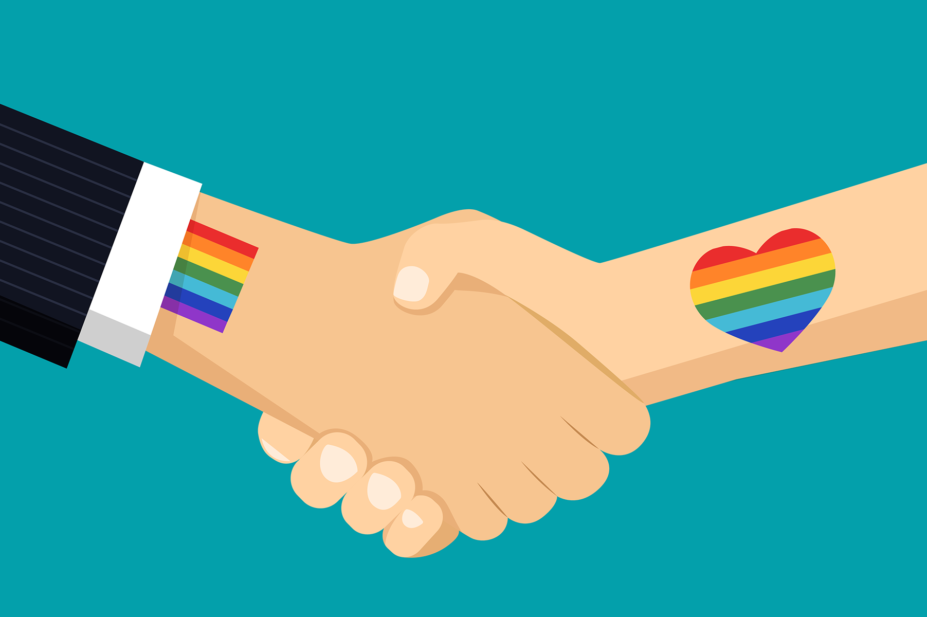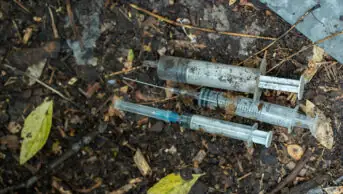
Mclean/Shuttterstock
Drug markets and the extent of drug use have evolved dramatically over the past two decades, with significant amounts of both known and unseen psychoactive substances emerging on online and street markets[1].
In her 2020 independent review of drugs commissioned by the government — the first national review of its kind in a long time — Dame Carole Black reported that the societal burden of drug use and drug-related harms in the UK amounted to approximately £20bn, which is far greater than the total value of the illicit drug market (a business that is worth approximately £9.4bn)[2].
In the general population, it is well established that substance misuse can be caused by underlying stressors, such as bereavement, poor mental health, trauma or being subjected to domestic violence[3,4]. However, it is less well known that being from a sexual minority group or experiencing discrimination can also be a risk factor for substance misuse[5].
Evidence suggests a disproportionate prevalence of substance use among the LGBTQ+ community compared with heterosexual counterparts[6,7]. However, it must be made clear that this does not mean every LGBTQ+ person has a substance misuse problem and research also suggests different trends within the diverse LGBTQ+ sub-populations[8].
Pharmacists can help to improve LGBTQ+ patients’ experience by creating a supportive, non-stigmatising environment that provides inclusive care
Increased prevalence in substance use among LGBTQ+ people has been associated with ‘heterosexual discrimination’, such as an individual: being connected with a religious group; being exploited through the ‘commercial gay scene’; undergoing peer pressure; coping with negative emotions, physical discomfort or stigmatisation (or ‘internalised homophobia’); or seeking the substance’s desired effects, such as feeling socially accepted, securing social connections and interactions, and improving confidence[8–13].
Data from the Center for American Progress — an independent, non-partisan policy institute — have shown high levels of substance use among LGBTQ+ people in the United States, which could be because LGBTQ+ individuals often face widespread discrimination, such as in the workplace or when trying access to housing, healthcare and social benefits[13].
This group is also at a higher risk of dual diagnoses of suicidal ideation disorders (SUD) and psychiatric disorders (e.g. low self-esteem, depression, anxiety, self-harm, suicidal ideation, mood and eating disorders)[13–15].
Psychiatric disorders can be triggered by hate crimes, such as harassment, bullying, violence and threats of violence, or feeling socially isolated and/or having disparities in healthcare, which are all things that can potentially lead to substance use[16]. For example, the Centre for American Progress estimated in 2012 that 30–40% of LGBTQ+ people in the United States smoked tobacco, while 25% abused alcohol, compared with 21% and 5–10% of their heterosexual counterparts, respectively[14].
Other data from multiple studies in different populations show that substance use of all kinds is higher among lesbian and bisexual women than in heterosexual women[17].
The trends seen in LGBTQ+ individuals can often reverse those seen in their heterosexual counterparts. In straight people, there are clear gender differences in drug use, which are not seen in LGBTQ+ communities and there are very different patterns of drug use according to age[16].
For example, a UK-based survey that interviewed 5,000 LGBTQ+ people in 2018 identified high prevalence of alcohol abuse disorders among older adults, with 33% of people aged 65 years and over reporting alcohol use each day, compared with 11% of people aged 25 to 34 years[6].
Substance misuse trends
People who use drugs, including members of the LGBTQ+ community, often do so to enhance the sexual experience[8,18]. Substances of abuse include cannabis, heroin, naturally-occurring psychoactive (such as Kava and magic mushrooms), hallucinogens (such as LSD), diverted prescription medicines (such as analgesics), hypnotics, steroids, barbiturates, inhalants (such as amyl nitrite), party drugs (such as ecstasy), methamphetamine, cocaine, ketamine, gamma hydroxybutyrate (GHB), as well as so-called ‘legal highs’ (such as mephedrone).
To understand why these drugs are used by LGBTQ+ people, it is important to consider the likely links to underlying stressors or mental health issues. For example, Australian national survey data from 2012 suggest that cannabis use may relieve psychological distress resulting from an inability to identify gender and sexual orientation in transgender and lesbian females, gay males and bisexual females[8].
In contrast, 3,4-Methylenedioxymethamphetamine, commonly known as MDMA or ecstasy, has been used to improve sociability and confidence. Methamphetamine, known as crystal meth, and cocaine are often the drugs of choice among gay men seeking stimulants and enhanced sexual experiences that are often coupled with overcoming feelings of rejection[19].
Drug use can be associated with high-risk sexual behaviours, which in LGBTQ+ populations have been associated with unprotected anal intercourse, poly-drug use or ‘slamming’, which involves injecting opioids, mephedrone and methamphetamine[18–20].
Support services
The diversity of LGBTQ+ sub-populations is not only associated with different substance use trends, but also in access to support services[8].
First, since these individuals are less likely to have a criminal record or to be registered in substance misuse treatment services they may not know of the support available. Use of novel psychoactive substances may allow people to continue functioning without major disruption to their professional lives, and others may try to avoid services altogether because they don’t want to be judged. Hence, LGBTQ+ populations are not in a position to be offered appropriate support unless they present to sexual health services, for example. Second, often services and treatment are not tailored to the specific needs of LGBTQ+ people [8,21].
This needs to change. Commissioners must address the systemic discrimination in substance misuse treatment service design and increase access for LGBTQ+ communities — including tailored interventions, such as holistic education and treatment that addresses the physical, mental and psychiatric needs of the older LGBTQ+ population with comorbidities. They should also improve awareness about interactions between recreational drugs and HIV treatments. For example, GHB may have enhanced effects owing to inhibition of CYP450 enzymes by the protease inhibitor ritonavir. A similar interaction can be seen with the co-consumption of ketamine (CYP 450 substrate) and efavirenz (CYP 3A4 inhibitor)[21]. Commissioners should also introduce bespoke services for patients with dual diagnoses, including of mental health or SUD.
Studies show that LGBTQ+ individuals respond to psychosocial interventions, including cognitive behavioural therapy (CBT), motivational interviewing, contingency management (where positive behaviours are reinforced) and brief harm reduction advice, coupled with pharmacological interventions (e.g. drug detoxification, HIV treatment) and specialist service referral (e.g. mental health services)[21,22]. These interventions and services can be accessed via drug and alcohol recovery services and are delivered by trained drug and alcohol teams, including pharmacists, doctors, nurses, recovery and case workers.
The role of pharmacy
Pharmacy has an important role. LGBTQ+ individuals may contact pharmacists through repeat prescription services, the new medicine service and other services[23].
Pharmacists can help to improve LGBTQ+ patients’ experience and enhance their access to healthcare by creating a supportive, non-stigmatising environment that provides inclusive care. The way to do this is through training and education on how pharmacy staff can adopt and promote inclusive language and attitudes towards LGBTQ+ individuals, which would enable this community to feel welcomed and unjudged.
Postgraduate and qualified pharmacists, technicians and pharmacy support staff should be trained on this topic, and it should be included on undergraduate pharmacy curricula.
Pharmacists and their teams need to maintain professional behaviours with and related to LGBTQ+ communities: behaviours should carry no assumptions, prevent misgendering, safeguard patient dignity and confidentiality, and appreciate the medical and pharmaceutical challenges of those who are going through gender transitioning.
Pharmacy teams are well placed to fill patients’ knowledge gaps related to targeted services and policies, where to find appropriate counselling and pharmaceutical care that meets their specific health needs. For example, pharmacy professionals can signpost to counselling on HIV and pre-exposure prophylaxis (PrEP) therapies, monitor treatment with hormone therapies, and refer to smoking or substance misuse services.
Substance misuse is a multifaceted international public health issue, which requires us to rethink the way we approach the care of LGBTQ+ individuals with problematic substance use and associated harms, and work towards reducing the significant health inequalities faced by these communities.
Amira Guirguis is MPharm programme director at Swansea University Medical School
- 1Global overview: drug demand and drug supply. United Nations Office on Drugs and Crime . 2021.https://www.unodc.org/res/wdr2021/field/WDR21_Booklet_2.pdf (accessed Mar 2022).
- 2Black C. Review of Drugs Executive Summary. Gov.uk. 2020.https://assets.publishing.service.gov.uk/government/uploads/system/uploads/attachment_data/file/897786/2SummaryPhaseOne+foreword200219.pdf (accessed Mar 2022).
- 3Cartwright P. Supporting People Bereaved through a Drug-or Alcohol-Related Death. UK: : Jessica Kingsley Publishers 2020. https://uk.jkp.com/products/supporting-people-bereaved-through-a-drug-or-alcoholrelated-death (accessed Apr 2022).
- 4Hughes TL, Eliason M. The Journal of Primary Prevention. 2002;22:263–98. doi:10.1023/a:1013669705086
- 5McCabe SE, Bostwick WB, Hughes TL, et al. The Relationship Between Discrimination and Substance Use Disorders Among Lesbian, Gay, and Bisexual Adults in the United States. Am J Public Health. 2010;100:1946–52. doi:10.2105/ajph.2009.163147
- 6Backmann C, Gooch B. LGBT in Britain: Health report. Stonewall. 2018.https://www.stonewall.org.uk/system/files/lgbt_in_britain_health.pdf (accessed Mar 2022).
- 7Drugs and Diversity: Lesbian, gay, bisexual and transgender (LGBT) communities Learning from the evidence. UK Drug Policy Commission. 2010.https://www.ukdpc.org.uk/wp-content/uploads/Policy%20report%20-%20Drugs%20and%20diversity_%20LGBT%20groups%20(policy%20briefing).pdf (accessed Mar 2022).
- 8Leonard W, Lyons A, Bariola E. A Closer Look at Private Lives2 Addressing the mental health and well-being of lesbian, gay, bisexual and transgender (LGBT) Australians. Australian Research Centre in Sex, Health and Society. 2015.https://www.rainbowhealthvic.org.au/media/pages/research-resources/a-closer-look-at-private-lives-2/1039450743-1605661766/a-closer-look-at-private-lives-2.pdf (accessed Mar 2022).
- 9Cogger A, Conover KJ, Israel T. Factors Influencing Alcohol Use Among Sexual Minority Women in a Non-Urban Community: A Mixed Methods Study. Journal of LGBT Issues in Counseling. 2012;6:293–309. doi:10.1080/15538605.2012.727745
- 10Halkitis PN, Parsons JT, Wilton L. An Exploratory Study of Contextual and Situational Factors Related to Methamphetamine Use among Gay and Bisexual Men in New York City. Journal of Drug Issues. 2003;33:413–32. doi:10.1177/002204260303300207
- 11Chard AN, Finneran C, Sullivan PS, et al. Experiences of homophobia among gay and bisexual men: results from a cross-sectional study in seven countries. Culture, Health & Sexuality. 2015;17:1174–89. doi:10.1080/13691058.2015.1042917
- 12Leonard W, Mitchell A, Pitts M. Coming forward: the underreporting of heterosexist violence and same sex partner abuse in Victoria. 2008. doi:10.4225/50/557E5C5B969DC
- 13Your Guide to LGBTQIAPK Addiction Treatment. American Addiction Centers. https://americanaddictioncenters.org/lgbtqiapk-addiction (accessed Mar 2022).
- 14Mental health statistics: LGBTIQ+ people. Mental Health Foundation. https://www.mentalhealth.org.uk/statistics/mental-health-statistics-lgbtiq-people (accessed Mar 2022).
- 15Han BH, Duncan DT, Arcila-Mesa M, et al. Co-occurring mental illness, drug use, and medical multimorbidity among lesbian, gay, and bisexual middle-aged and older adults in the United States: a nationally representative study. BMC Public Health. 2020;20. doi:10.1186/s12889-020-09210-6
- 16Green KE, Feinstein BA. Substance use in lesbian, gay, and bisexual populations: An update on empirical research and implications for treatment. Psychology of Addictive Behaviors. 2012;26:265–78. doi:10.1037/a0025424
- 17Duvivier RJ, Wiley E. WHO and the health of LGBT individuals. The Lancet. 2015;385:1070–1. doi:10.1016/s0140-6736(15)60595-5
- 18Claire Van Hout M, Brennan R. “Bump and grind”: an exploratory study of Mephedrone users’ perceptions of sexuality and sexual risk. Drugs and Alcohol Today. 2011;11:93–103. doi:10.1108/17459261111174046
- 19Guss JR. Sex Like You Can’t Even Imagine. Journal of Gay & Lesbian Psychotherapy. 2000;3:105–22. doi:10.1300/j236v03n03_09
- 20Substance misuse services for men who have sex with men involved in chemsex. Public Health England. 2015.https://assets.publishing.service.gov.uk/government/uploads/system/uploads/attachment_data/file/669676/Substance_misuse_services_for_men_who_have_sex_with_men_involved_in_chemsex.pdf (accessed Mar 2022).
- 21Abdulrahim D, Whiteley C, Moncrieff M, et al. Club Drug Use Among Lesbian, Gay, Bisexual and Trans (LGBT) People. Novel Psychoactive Treatment UK Network. 2016.http://neptune-clinical-guidance.co.uk/wp-content/uploads/2016/02/neptune-club-drug-use-among-lgbt-people.pdf (accessed Mar 2022).
- 22Ackermann K, Kaliszewski M. Why Substance Abuse is Higher within the LGBTQ Community. American Addiction Centers. 2021.https://americanaddictioncenters.org/lgbtqiapk-addiction/why-substance-abuse-is-higher-within-the-lgbtq-community (accessed Mar 2022).
- 23LGBTQ people’s experiences of medicines and pharmacies. Brighton and Hove LGBTQ Switchboard. 2017.https://www.switchboard.org.uk/wp-content/uploads/2013/09/LGBTQ-Medicines-and-Pharmacies-Report-Final.pdf (accessed Mar 2022).


